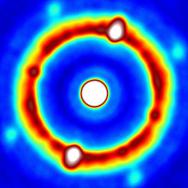Researchers have big ideas for the potential of quantum technology, from unhackable networks to earthquake sensors. But all these things depend on a major technological feat: being able to build and control systems of quantum particles, which are among the smallest objects in the universe.
That goal is now a step closer with the publication of a new method by University of Chicago scientists. Published April 28 in Nature, the paper shows how to bring multiple molecules at once into a single quantum state—one of the most important goals in quantum physics.
“People have been trying to do this for decades, so we’re very excited,” said senior author Cheng Chin, a professor of physics at UChicago who said he has wanted to achieve this goal since he was a graduate student in the 1990s. “I hope this can open new fields in many-body quantum chemistry. There’s evidence that there are a lot of discoveries waiting out there.”
One of the essential states of matter is called a Bose-Einstein condensate: When a group of particles cooled to nearly absolute zero share a quantum state, the entire group starts behaving as though it were a single atom. It’s a bit like coaxing an entire band to march entirely in step while playing in tune—difficult to achieve, but when it happens, a whole new world of possibilities can open up.
Scientists have been able to do this with atoms for a few decades, but what they’d really like to do is to be able to do it with molecules. Such a breakthrough could serve as the underpinning for many forms of quantum technology.
But because molecules are larger than atoms and have many more moving parts, most attempts to harness them have dissolved into chaos. “Atoms are simple spherical objects, whereas molecules can vibrate, rotate, carry small magnets,” said Chin. “Because molecules can do so many different things, it makes them more useful, and at the same time much harder to control.”
Chin’s group wanted to take advantage of a few new capabilities in the lab that had recently become available. Last year, they began experimenting with adding two conditions.
The first was cooling the entire system down even further—down to 10 nanokelvins, a split hair above absolute zero. Then they packed the molecules into a crawl space so that they were pinned flat. “Typically, molecules want to move in all directions, and if you allow that, they are much less stable,” said Chin. “We confined the molecules so that they are on a 2D surface and can only move in two directions.”
The result was a set of virtually identical molecules—lined up with exactly the same orientation, the same vibrational frequency, in the same quantum state.
The scientists described this molecular condensate as like a pristine sheet of new drawing paper for quantum engineering. “It’s the absolute ideal starting point,” Chin said. “For example, if you want to build quantum systems to hold information, you need a clean slate to write on before you can format and store that information.”
So far, they’ve been able to link up to a few thousand molecules together in such a state, and are beginning to explore its potential.
“In the traditional way to think about chemistry, you think about a few atoms and molecules colliding and forming a new molecule,” Chin said. “But in the quantum regime, all molecules act together, in collective behavior. This opens a whole new way to explore how molecules can all react together to become a new kind of molecule.
“This has been a goal of mine since I was a student,” he added, “so we’re very, very happy about this result.”
The first author on the study was graduate student Zhendong Zhang; the other two authors were Shanxi University’s Liangchao Chen (formerly a visiting scholar at UChicago) and graduate student Kaixuan Yao.
Citation: “Transition from an atomic to a molecular Bose–Einstein condensate.” Zhang, Chen, Yao and Chin, Nature, April 28, 2021.
Funding: National Science Foundation, Army Research Office, University of Chicago Materials Research Science and Engineering Center.

